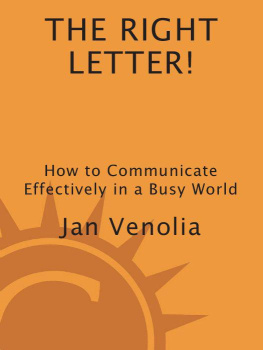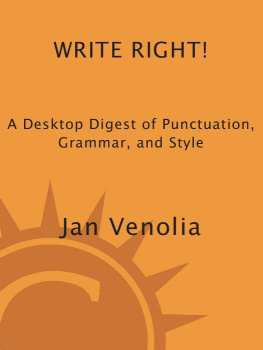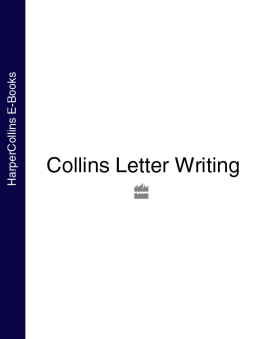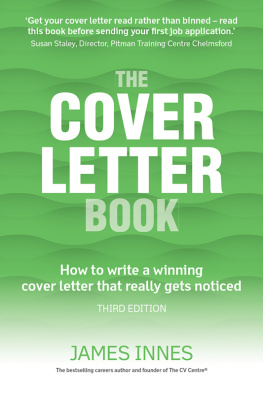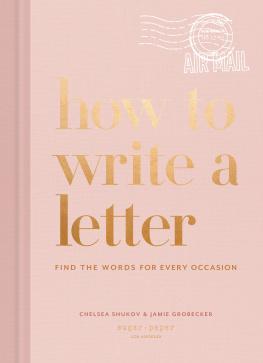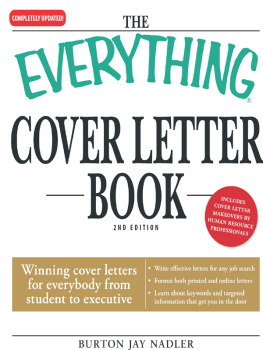Copyright 2004 by Jan Venolia
All rights reserved. No part of this book may be reproduced in any form, except brief excerpts for the purpose of review, without written permission of the publisher.
Originally published by Ten Speed Press as Better Letters: A Handbook of Business and Personal Correspondence, 1981, 1982, 1995 by Janet G. Venolia.

Ten Speed Press
Box 7123
Berkeley, California 94707
www.tenspeed.com
Distributed in Australia by Simon & Schuster Australia, in Canada by Ten Speed Press Canada, in New Zealand by Southern Publishers Group, in South Africa by Real Books, and in the United Kingdom and Europe by Airlift Book Company.
Illustrations by Ellen Sasaki
Ask Dr. Science excerpt on .
Snail Mail on verse copyright Indian Hill Press. All Rights Reserved. Reprinted with permission.
Library of Congress Cataloging-in-Publication Data
Venolia, Jan.
The right letter! : how to communicate effectively in a busy world / Jan Venolia.
p. cm.
Rev. ed. of: Better letters. 2nd ed. c1995.
eISBN: 978-0-307-78420-9
1. Letter writingHandbooks, manuals, etc. 2. English languageRhetoricHandbooks, manuals, etc. 3. Commercial correspondenceHandbooks, manuals, etc. 4. Interpersonal communicationHandbooks, manuals, etc.
I. Venolia, Jan. Better letters. II. Title.
PE1483.V4 2004
808.6dc22
2004015746
v3.1
To my amazing grandchildren,
Riley, Celeste, Analisa, and Marisela.
Write to your grandmother!
An odd thought strikes me: We shall
receive no letters in the grave.
Samuel Johnson
In the meantime
Jan Venolia

Contents

Our correspondences have wingspaper birds that fly from my house to yoursflocks of ideas crisscrossing the country. Once opened, a connection is made. We are not alone in the world.
Terry Tempest Williams
Acknowledgments
There are some hazards associated with being one of my friends or a member of my family. At any given time, you might be asked to critique a manuscript, suggest suitable topics or examples of errors, devise goofy names, or be queried about pet peeves (such as common grammatical errors or email overload). Your conversation and correspondence might be mined for quotes or other usable bits.
It is a mark of true friendship and an indication of the strength of family ties that such help has not only been forthcoming but unstinting, plenteous, and accompanied by a generous dollop of good humor.
For this particular book, I give heartfelt thanks to the following stalwart souls:
Carrie, Skylar and Ward Anderson, Joyce Cass, Carmen Ramos Chandler, Al Chapman, Emily Copeland, Pat Ditzler, Marcia Dorst, Amir Hussain, Peggy Holloway, Mark Jackson, Peg Myers, Jay Thoman, and the core Venolias: Carol, Lee, Malcolm, and Wayne.
The editor responsible for weaving all the strands together has been Ten Speeds Kathryn Hashimoto, impresario extraordinaire. Thanks, Kathy!

Mail Call
Letters illuminate emotion, humanity, and fortitude in a way that is always fresh and enduring. They are the color, heart, and personality of history.
Dorie McCullough Lawson
Do people still write letters? With so many other ways to communicate, have letters been crowded out?
Not at all! Letters help people do important things: Land a job, make a sale, express thanks, send condolences, or simply keep in touch. Letters are less intrusive than the telephone, giving both writer and reader the luxury of a second look. You cant revise whats been said in a phone call, let alone remember exactly what was said.
The Right Letter! covers both business and personal correspondence, from cover letters for resumes to thank-you notes. The book also includes suggestions for improving your email style and for reducing the number of groans that email often provokes.
Because business letters usually affect your livelihood, most of the pages that follow are devoted to writing effective business letters and email. Personal letters, by their nature, will be written and read in a more relaxed way; nonetheless, if the help youre looking for is how to write a letter of sympathy, youll find it here as well.
The Right Letter! does not cover such standardized forms of business communication as interoffice memos or fax cover sheets. Nor is it a manual of instructions for the email novice. It doesnt advise you about equipment, discuss the technical aspects of connecting to the Internet, or acquaint you with the joys and hazards of blogs and newsgroups. The Right Letter! does provide suggestions for improving your email style. By implementing these ideas, you might just find that youre helping make email more useful and enjoyable for everyone.
Is the message you send by email pretty much like the letter you send by snail mail? No. You toss off a casual email message with little or no revision, unconcerned whether it would make your English teacher beamor wince. If youre applying for a job, however, thats clearly another matter. You need to give each kind of message its due. Start by sorting your communication along the following lines.
Use the U.S. Postal Service to send:
- job applications
- cover letters (e.g., accompanying a proposal)
- letters that are two or more pages long
- material concerning confidential matters
- letters that call for official signatures (such as contracts or letters of agreement)
- sympathy and personal thank-you letters
Use a fax for:
- sending a hard copy quickly
- providing customer support (e.g., instructions, parts lists)
Use email for:
- sending short, informal messages
- making group announcements
Use the telephone or instant messaging:
- when you need an immediate response
- if the subject requires discussion
- for the back-and-forth of brainstorming
Three out of four of these methods of communicating require that you know how to write. Unfortunately, people are increasingly unsure of how to choose and organize wordsan uncertainty you may feel yourself. The Right Letter! will help you develop the skills and confidence you need to become a better letter-writer.
The Right Letter! is divided into three parts. In P ART O NE , Business Letters, the basics of style and organization are presented in , Examples of Business Letters, translates matters of style, organization, and appearance into sample lettersnot as templates for you to mimic, but as suggestions to stimulate your creative juices.
P ART Two, Personal Letters, covers the kinds of letters you are called upon to write as friend, consumer, and citizen.

